Canoe adventure on the Seal River
The Seal River 2019
There are mixed emotions when checking off a bucket list item. Excitement for the accomplishment, wonderful memories from the trip but it also leaves a little hole in your life. Paddling the Seal River into Hudson Bay and getting to see Churchill, Manitoba has long been a goal of mine. Having paddled the voyageur highways of the Churchill River in northern Saskatchewan and telling stories to groups about how these waterways were used and mapped our existence today, it was pretty amazing to arrive in Churchill to see the place where all those journeys began. The Seal River has also been considered one of the more challenging paddling trips in Canada due to the remoteness, incredible amount of white-water, and dangers of encountering polar bears. To further fuel my interest in the river, there is a history of great Saskatchewan paddlers that canoed the Seal River as far back as the 70’s and even provided the notes on the Seal River trip that helped create the guide book many use to paddle the river today.
Our trip was over 4 years in the making due to our first attempt at the Seal River being cancelled when the rail line shut down between Churchill and Thompson due to flooding. Without rail travel we did not have an inexpensive way to get our canoes and gear out of Churchill, so our trip was postponed until the railway could run again. Needless to say, when we got word that the rail line was finally sold and was to be used again in 2019, we were pretty excited. We had our original group of 4 still ready and willing but wanted a group of 6 for the safety and security of paddling all those rapids and dealing with any wildlife issues. With the Seal River being such an iconic river there was no shortage of interest in joining us, and ended up finding our 6 for the trip.
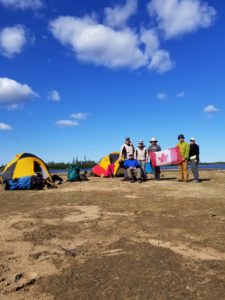 Seal Team 2019 is what we dubbed ourselves, on about the 5th day of the trip. Our paddling members consisted of myself and my wife Regan, Colin Frey, his paddling partner Laurie Weiman, and Kevin Pilsworth and Dean Douglas, (aka “Dean-er-ino”) made up the third canoe. Kevin was the new person to our crew having never paddled with anyone else in our group, other than taking a canoe course with me many years ago. His tripping experience, white water paddling skill and firearm experience would be a great asset to our group. Colin was our polar bear expert, having spent many years in various guiding roles in Churchill, MB and one of the best darn campers in North America. Colin runs a business called Renewed by Nature teaching canoeing, camping, wilderness first aid, survival skills, and bush craft skills. Dean & Laurie have been on many paddling trips with us before including the Cree River & Clearwater River, and are great campers & paddlers. But most important for any canoe expedition, they are both just great people to spend time with. Having planned a good portion of the trip years ago, we had a lot of the pieces in place to get the trip off the ground. Maps had already been purchased, guidebooks had already been studied, and travel logistics like flights and travel had points of contact. We had planned to drive to Thompson and charter a float plane with Wings Over Kississing to fly into Tadoule Lake. We would then paddle the river and get a shuttle from the mouth of the river in Hudson Bay back to Churchill. In many of the notes the shuttle recommendation was to contact Jackie Badstone from Churchill to make the trip. Jackie also owns the little shack on the coast where people can hold out until the weather is suitable for a pickup. Upon contacting Jackie he was not available so we started to look for other shuttle options. Colin contacted Wally from Lazy Bear Lodge who he had previously worked for and Wally was more than happy to coordinate with us to arrange a shuttle. Then train tickets needed to be booked, and for only $6 more per ticket we would be able to change the dates on them if needed, so that was a huge bargain. We also had to notify VIA Rail that we had 3 canoes to haul so they were aware of the space required. With the main logistics in place we were ready to fill in the smaller, easy details of the trip, so it was very exciting to know it was all a go.
Seal Team 2019 is what we dubbed ourselves, on about the 5th day of the trip. Our paddling members consisted of myself and my wife Regan, Colin Frey, his paddling partner Laurie Weiman, and Kevin Pilsworth and Dean Douglas, (aka “Dean-er-ino”) made up the third canoe. Kevin was the new person to our crew having never paddled with anyone else in our group, other than taking a canoe course with me many years ago. His tripping experience, white water paddling skill and firearm experience would be a great asset to our group. Colin was our polar bear expert, having spent many years in various guiding roles in Churchill, MB and one of the best darn campers in North America. Colin runs a business called Renewed by Nature teaching canoeing, camping, wilderness first aid, survival skills, and bush craft skills. Dean & Laurie have been on many paddling trips with us before including the Cree River & Clearwater River, and are great campers & paddlers. But most important for any canoe expedition, they are both just great people to spend time with. Having planned a good portion of the trip years ago, we had a lot of the pieces in place to get the trip off the ground. Maps had already been purchased, guidebooks had already been studied, and travel logistics like flights and travel had points of contact. We had planned to drive to Thompson and charter a float plane with Wings Over Kississing to fly into Tadoule Lake. We would then paddle the river and get a shuttle from the mouth of the river in Hudson Bay back to Churchill. In many of the notes the shuttle recommendation was to contact Jackie Badstone from Churchill to make the trip. Jackie also owns the little shack on the coast where people can hold out until the weather is suitable for a pickup. Upon contacting Jackie he was not available so we started to look for other shuttle options. Colin contacted Wally from Lazy Bear Lodge who he had previously worked for and Wally was more than happy to coordinate with us to arrange a shuttle. Then train tickets needed to be booked, and for only $6 more per ticket we would be able to change the dates on them if needed, so that was a huge bargain. We also had to notify VIA Rail that we had 3 canoes to haul so they were aware of the space required. With the main logistics in place we were ready to fill in the smaller, easy details of the trip, so it was very exciting to know it was all a go.
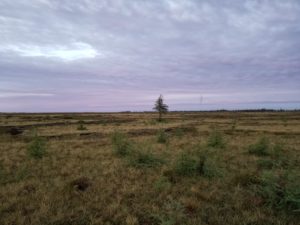 A big draw to paddling the Seal River is the large number of rapids you get to run. From Tadoule Lake to the bay, a distance of approximately 240km there are an estimated 42 rapids and a vertical drop of 240 feet. Novel to the Seal River there are no waterfalls to make up the vertical drop in feet, so there are a lot of runnable rapids. Most of the rapids are long stretches of continuous white-water with famous rapids like Nine Bar, Bastion Rock, and Deaf Rapids. Some stretches of rapids are 3 km to 12 km in length too. We came prepared to run them all with some great gear. We were paddling 3 Clipper canoes, two of them were 17’ Prospectors in the Kevlar/Duraflex layup, bar none the absolute best wilderness canoe you could ever paddle. Our 3rd canoe was an 18’6” Clipper Mackenzie built with Kevlar and a little s-glass reinforcement in the hull.
A big draw to paddling the Seal River is the large number of rapids you get to run. From Tadoule Lake to the bay, a distance of approximately 240km there are an estimated 42 rapids and a vertical drop of 240 feet. Novel to the Seal River there are no waterfalls to make up the vertical drop in feet, so there are a lot of runnable rapids. Most of the rapids are long stretches of continuous white-water with famous rapids like Nine Bar, Bastion Rock, and Deaf Rapids. Some stretches of rapids are 3 km to 12 km in length too. We came prepared to run them all with some great gear. We were paddling 3 Clipper canoes, two of them were 17’ Prospectors in the Kevlar/Duraflex layup, bar none the absolute best wilderness canoe you could ever paddle. Our 3rd canoe was an 18’6” Clipper Mackenzie built with Kevlar and a little s-glass reinforcement in the hull.
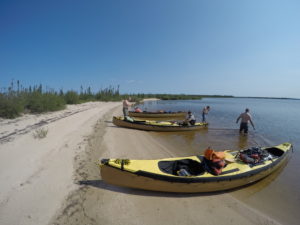 I chose to have a larger canoe to nest the 17’ into rather than the more traditional way of nesting a 16’ in a 17’ boat. On longer trip such as this it’s sure nice to have the extra capacity, and all three canoes were outfitted with North Water spray decks to keep the water out while paddling in the big waves. I have been paddling skirted canoes for a long time now and I can’t stress how amazing they are. When paddling white-water, they are fantastic to keep the water out, which is the leading cause of tipping. When paddling on lakes they keep you cool and protected from the hot sun, and on cold rainy days they help to keep you warm. The North Water decks you can buy today are loaded with features that have come about from trial and error. I am on my 3rd skirt now and I am still adding features and changing the configuration around. If you are buying your first deck the North Water team will be a huge help to you. I have installed my own spray skirts, and for friends, but I highly recommend having a new canoe built by the masters at Clipper Canoes, then having your skirt sent to them and paying the labour charge for installation. The small fee and professional install are worth it and save you the extra stress.
I chose to have a larger canoe to nest the 17’ into rather than the more traditional way of nesting a 16’ in a 17’ boat. On longer trip such as this it’s sure nice to have the extra capacity, and all three canoes were outfitted with North Water spray decks to keep the water out while paddling in the big waves. I have been paddling skirted canoes for a long time now and I can’t stress how amazing they are. When paddling white-water, they are fantastic to keep the water out, which is the leading cause of tipping. When paddling on lakes they keep you cool and protected from the hot sun, and on cold rainy days they help to keep you warm. The North Water decks you can buy today are loaded with features that have come about from trial and error. I am on my 3rd skirt now and I am still adding features and changing the configuration around. If you are buying your first deck the North Water team will be a huge help to you. I have installed my own spray skirts, and for friends, but I highly recommend having a new canoe built by the masters at Clipper Canoes, then having your skirt sent to them and paying the labour charge for installation. The small fee and professional install are worth it and save you the extra stress.
Every canoe trip is a wonderful opportunity to see wildlife in its natural habitat and paddling the Seal River in northern Manitoba would offer us the chance to possibly see polar bears. This of course meant precautions would need to be taken and protection such as air horns, bangers, and shot guns would be included.
 The wildlife viewing on this trip began on the very first day when we were treated to a visit from a few seals on Shethenai Lake. They were curious and playful like otters, but with their larger size the splashes were more like that of a beaver slapping its tail. We saw dozens of seals every day on the river and as we got closer to the coast, we would see seals laying on rocks out of the water, perfectly camouflaged with their grey colour. The seals we saw during the first half of the trip were not as scared of us as the ones we saw in the last half, closer to Hudson Bay. One could assume the seals closer to Shethenai Lake are not hunted by polar bears as much as the Hudson Bay ones, so they are a little more trusting. They were wonderful entertainment to watch during the entire trip. There was also no shortage of bald eagles and we were even treated to an amazing view of a golden eagle swooping down from his perch only a few yards away from us.
The wildlife viewing on this trip began on the very first day when we were treated to a visit from a few seals on Shethenai Lake. They were curious and playful like otters, but with their larger size the splashes were more like that of a beaver slapping its tail. We saw dozens of seals every day on the river and as we got closer to the coast, we would see seals laying on rocks out of the water, perfectly camouflaged with their grey colour. The seals we saw during the first half of the trip were not as scared of us as the ones we saw in the last half, closer to Hudson Bay. One could assume the seals closer to Shethenai Lake are not hunted by polar bears as much as the Hudson Bay ones, so they are a little more trusting. They were wonderful entertainment to watch during the entire trip. There was also no shortage of bald eagles and we were even treated to an amazing view of a golden eagle swooping down from his perch only a few yards away from us.
 We were lucky to get a close view of a large grey wolf while we were on shore scouting the final ledges of Nine Bar Rapids. The wind was blowing from the same direction the wolf was walking toward us, so he couldn’t smell us, and didn’t stop coming toward us until we made some noise with our whistles, yelled and waved our paddles at him. Reading notes from other folks paddling the Seal River, they explain that they never got to see a polar bear; which is great from a safety standpoint, but we were all hoping to safely see a bear. On day 7 of our trip we had our first polar bear sighting. We had just finished paddling a long stretch of class 2-3 rapids, (about 3-4km long stretch) and I spotted a white bear walking along the river left shore. Previous to this we had seen a countless number of “polar boulders” which are suspicious looking white rocks which are shaped very much like a polar bear lying in the bushes, but of course don’t move. Well this white rock was moving, and she had 2 young cubs rumbling along behind her! Colin figured she was this far inland (about 60km from the bay) to help keep her cubs safe from the male bears. She looked healthy and had a beautiful white coat of fur, but her cubs were both still a dirty blonde colour. We watched her take notice of us as we were paddling by and she perched on a shore rock and started to sniff at us to figure out what we were and if we were a threat. Her cubs stood close
We were lucky to get a close view of a large grey wolf while we were on shore scouting the final ledges of Nine Bar Rapids. The wind was blowing from the same direction the wolf was walking toward us, so he couldn’t smell us, and didn’t stop coming toward us until we made some noise with our whistles, yelled and waved our paddles at him. Reading notes from other folks paddling the Seal River, they explain that they never got to see a polar bear; which is great from a safety standpoint, but we were all hoping to safely see a bear. On day 7 of our trip we had our first polar bear sighting. We had just finished paddling a long stretch of class 2-3 rapids, (about 3-4km long stretch) and I spotted a white bear walking along the river left shore. Previous to this we had seen a countless number of “polar boulders” which are suspicious looking white rocks which are shaped very much like a polar bear lying in the bushes, but of course don’t move. Well this white rock was moving, and she had 2 young cubs rumbling along behind her! Colin figured she was this far inland (about 60km from the bay) to help keep her cubs safe from the male bears. She looked healthy and had a beautiful white coat of fur, but her cubs were both still a dirty blonde colour. We watched her take notice of us as we were paddling by and she perched on a shore rock and started to sniff at us to figure out what we were and if we were a threat. Her cubs stood close
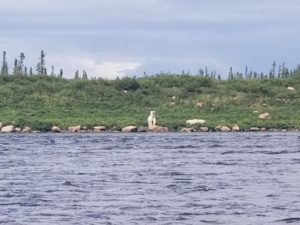 beside her, almost underneath, and it was picture perfect like a Christmas Coca-Cola commercial (except without the professional photographers.) We continued paddling down river and she rambled on upstream with the cubs in tow. The very next day we were fortunate once again to see another polar bear, this time a young male bear. We surprised him on the right shoreline, and he ran along the shore for 40 yards or so before jumping into the water. This made us a bit nervous, so we paddled over to the left side of the river to give him LOTS of room. The last 2 bears we were fortunate to see were right on the coast as we paddled into the bay, where you would expect to see the most bears. They had just come off the ice a few weeks before we got there so they were still hunting seals and beluga whales in the large tidal flats. The large male polar bear was huge and would be probably be pushing the 1500 lb range that these massive animals can get up to. Behind him, although further back, was another bear. During the entire trip we saw 5 polar bears in total, including the bear cubs, which was pretty amazing. We were fortunate to not have any issues with them in our camp at any time. The last wildlife surprise on our journey were the beluga whales in Hudson Bay. We were first treated with the awe and wonder of seeing them from our canoes, then again while Wally was taking us back to Churchill in his power boat, we got the executive tour. We even stopped for a while, amongst hundreds and hundreds of whales, which was absolutely amazing to watch!
beside her, almost underneath, and it was picture perfect like a Christmas Coca-Cola commercial (except without the professional photographers.) We continued paddling down river and she rambled on upstream with the cubs in tow. The very next day we were fortunate once again to see another polar bear, this time a young male bear. We surprised him on the right shoreline, and he ran along the shore for 40 yards or so before jumping into the water. This made us a bit nervous, so we paddled over to the left side of the river to give him LOTS of room. The last 2 bears we were fortunate to see were right on the coast as we paddled into the bay, where you would expect to see the most bears. They had just come off the ice a few weeks before we got there so they were still hunting seals and beluga whales in the large tidal flats. The large male polar bear was huge and would be probably be pushing the 1500 lb range that these massive animals can get up to. Behind him, although further back, was another bear. During the entire trip we saw 5 polar bears in total, including the bear cubs, which was pretty amazing. We were fortunate to not have any issues with them in our camp at any time. The last wildlife surprise on our journey were the beluga whales in Hudson Bay. We were first treated with the awe and wonder of seeing them from our canoes, then again while Wally was taking us back to Churchill in his power boat, we got the executive tour. We even stopped for a while, amongst hundreds and hundreds of whales, which was absolutely amazing to watch!
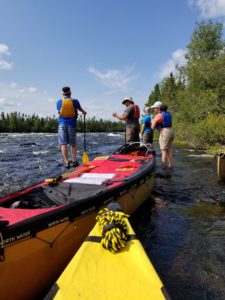 Depending where you start paddling on the Seal River will determine which rapids you run first. Lots of folks seem to come in from the North Seal or down the Wolverine, so there are a few rapids between Tadoule Lake and Shethanei Lake that they would miss. Truthfully the rapid that gave me the most stress on this trip was a listed Class 2 in between Negassa Lake and Shethanei Lake. The notes on this C2 were to stay right to avoid the rock garden and left of the ledges. The approach to this rapid is a C1 tech run, which involves dodging a few rocks here and there. As we were approaching it from the top, I was thinking we will make our way to the right and will be able to see the way down. What I saw was a bunch of pillows and ledges that didn’t line up well at all. We quickly got over to river right to get out and take a look at this rapid. There is a nice point of land that we waded and hiked over to so that we could get a better look at the ledges. The middle right line looked great but the approach from the top was littered with rocks. There was also a wave train out the bottom that you would not want to be stuck in the middle of and paddling on the right of it meant some shallow rocks lower down. There seemed to be a nice line just to the left of the wave train that we decided upon, but it was getting far enough away from our scouting point and obstructed by the wave train, so it created a little bit of doubt. Once we got back to the canoes, I second guessed the plan while going over it with the team, so I quickly went back for a second look. Colin came with me and we were able to get a better vantage point with a little more bushwakking, and we decided to go left of the wave train instead of right. The little bit of doubt added to the excitement. One thought in my mind was that with paddling the longer 18’ canoe I would not have the same manoeuverability as what I was used to in my 17’. We worked our way back up to the top of the rapid walking and wadding through the shallow rocks. We had some options at the top as far as which way to approach but once we hit the ledges and waves we needed to be in the correct spot. Passing the last ledge, we could see that left of the wave train was the correct choice and all three canoes were successful in running it. We then started to discuss the difficulty of this “Class 2” rapid, and with considering changing water levels we thought “man this could be a tough river!” Next was a 1km long Class 3 rapid around a bend and we approached it with caution and concern because of the C2 that gave us such a challenge. This proved to be a nice wide open rapid with lots of room to miss the holes and boulders and we were able to run it successfully after a quick scout from the canoe. This brought us to the famous Samuel Hearne camp site we were looking for and the evening was a conversation about the now infamous C2 and the rapids that were yet to come.
Depending where you start paddling on the Seal River will determine which rapids you run first. Lots of folks seem to come in from the North Seal or down the Wolverine, so there are a few rapids between Tadoule Lake and Shethanei Lake that they would miss. Truthfully the rapid that gave me the most stress on this trip was a listed Class 2 in between Negassa Lake and Shethanei Lake. The notes on this C2 were to stay right to avoid the rock garden and left of the ledges. The approach to this rapid is a C1 tech run, which involves dodging a few rocks here and there. As we were approaching it from the top, I was thinking we will make our way to the right and will be able to see the way down. What I saw was a bunch of pillows and ledges that didn’t line up well at all. We quickly got over to river right to get out and take a look at this rapid. There is a nice point of land that we waded and hiked over to so that we could get a better look at the ledges. The middle right line looked great but the approach from the top was littered with rocks. There was also a wave train out the bottom that you would not want to be stuck in the middle of and paddling on the right of it meant some shallow rocks lower down. There seemed to be a nice line just to the left of the wave train that we decided upon, but it was getting far enough away from our scouting point and obstructed by the wave train, so it created a little bit of doubt. Once we got back to the canoes, I second guessed the plan while going over it with the team, so I quickly went back for a second look. Colin came with me and we were able to get a better vantage point with a little more bushwakking, and we decided to go left of the wave train instead of right. The little bit of doubt added to the excitement. One thought in my mind was that with paddling the longer 18’ canoe I would not have the same manoeuverability as what I was used to in my 17’. We worked our way back up to the top of the rapid walking and wadding through the shallow rocks. We had some options at the top as far as which way to approach but once we hit the ledges and waves we needed to be in the correct spot. Passing the last ledge, we could see that left of the wave train was the correct choice and all three canoes were successful in running it. We then started to discuss the difficulty of this “Class 2” rapid, and with considering changing water levels we thought “man this could be a tough river!” Next was a 1km long Class 3 rapid around a bend and we approached it with caution and concern because of the C2 that gave us such a challenge. This proved to be a nice wide open rapid with lots of room to miss the holes and boulders and we were able to run it successfully after a quick scout from the canoe. This brought us to the famous Samuel Hearne camp site we were looking for and the evening was a conversation about the now infamous C2 and the rapids that were yet to come.
In modern day canoe tripping we paddlers have a tendency to research the “adventure” out of the trip. We pour over notes so we can choose the best camping spots, have the most information available to us to safely run the rapids, or know where the portages are to safely avoid the rapids. I too can be guilty of this, and only in the past few years have I begun to understand what I am doing. The conditions of rapids can drastically change from one year to another depending on the water level, erosion, or ice push. The best we can do is assess each rapid independently and make the best decision with the information we have. A popular guidebook for the Seal River is Hap Wilson’s book, Rivers in Manitoba, and throughout my research on the Seal there was much debate on the quality or accuracy of his book. The first thing I noticed about his book was the lack of UTM’s provided. I have gotten accustomed to plotting UTM’s from guidebooks or fellow paddlers’ notes. Hap’s notes were more of a story format to which his latest book, River of Fire, is a testimonial to his story telling ability. Now I may not be 100% certain, but I believe Hap’s first trip down the Seal River was when he guided two American writers and brought his friend with him as an assistant/helper. It was on this trip where he faced all the fires that he paddled through, by, or in-front of. He mentions in this book how he has only the notes from the Canadian Heritage Rivers System, but what he fails to reference is the detailed notes of the rapids that he received 2nd hand from Kevin Schultz. Kevin Schultz was a guide and canoe instructor based out of Missinipe, SK and worked for Churchill River Canoe Outfitters. The single largest factor of why I was paddling on the Seal River was because of all the paddling, white-water training, camp, and canoe travel skills bestowed upon me from assisting and teaching with Kevin for many, many years. I only found out that Kevin’s notes made it to Hap while I was having a conversation with Kevin about the Seal River. I said to him, “there is something odd about these notes on the rapids on the Seal” to which he responded, “Careful, before you say anything too bad, those notes came from me.” Amazed that he had never mentioned this to me in all the years knowing him, we discussed this for some time before I clarified that my issue was with the drawings of each rapid and if we could trust the accuracy of the drawings. Always my canoe teacher, he just reminded me to scout each rapid with the information at hand and make the best decision I could. Whether we love, like, or dislike Hap’s book, we have to respect and appreciate his work and take what we can from it. In the end I do appreciate that Hap made notes about the Seal River while guiding strangers and being chased by fires, and I thank him for not taking the “adventure” away from my trip.
Day 4 of our trip was to be a long day of paddling, all on river, as we made our way to the Great Island. Our camp spot the night before was up high on an esker which allowed us to go for a wonderful hike to take in some amazing views. As we had seen from the plane, northern Manitoba is super flat and thus even the smallest esker, or height of land, offered some amazing views. We hiked on eskers following animal tracks and wondered about how few people would ever experience what we were doing. From this height of land we were able to see the river ahead, and how it narrowed a little which would help create the many rapids we would yet encounter. By the count on the map there would be at least 9-C2 rapids and 2-C3s. The distance to cover was nearly 40km and we were making great time until a huge headwind kicked up which negated the advantage from the current of the river. The Great Island is where the Seal River splits and flows around it to both the north and south. Once we reached the Great Island, we were disappointed to find a very dirty campsite left amongst all this pristine wilderness. Some items were very old, including discarded fuel canisters, but some items were from this year and included reusable grocery bags from the Northern Store. Choosing not to camp here for fear of animal visits, we cleaned up what we could and moved on to find a better, safer site.
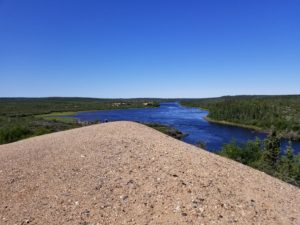 Every day of the trip was a new adventure and some days had features we were eager to see, or rapids we were excited to paddle, and Bastion Rock was both! Bastion Rock is a large rock formation carved by many years of erosion where the main flow of water travels through the center and left of the river, but on the right, you can paddle in behind this large rock formation. The rapid is classed as a C3-4 but the lead into the rapid is a manageable class 1-plus. As you paddle around this rock, canyon walls head straight up blocking the sky. We knew we wanted to get out and hike on this rock which would also give us a great vantage point to see the C4 coming up around the bend. We found a little inlet where run-off flows into the river and tied up our canoes so we could scramble up the rock.
Every day of the trip was a new adventure and some days had features we were eager to see, or rapids we were excited to paddle, and Bastion Rock was both! Bastion Rock is a large rock formation carved by many years of erosion where the main flow of water travels through the center and left of the river, but on the right, you can paddle in behind this large rock formation. The rapid is classed as a C3-4 but the lead into the rapid is a manageable class 1-plus. As you paddle around this rock, canyon walls head straight up blocking the sky. We knew we wanted to get out and hike on this rock which would also give us a great vantage point to see the C4 coming up around the bend. We found a little inlet where run-off flows into the river and tied up our canoes so we could scramble up the rock.
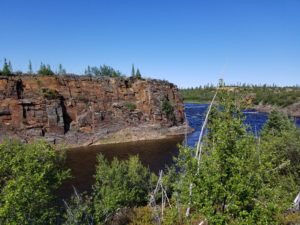 The scramble was a huge change from the previous shore hikes which were all on sandy eskers. As we hiked the ridge back towards the main channel to see the flow, we were taken in with the views in 360 degrees around us. Primarily old burn but unique rock formations to the south, and sandy eskers to the north. Where the esker to the north meets the river downstream was supposed to be a campsite so we paid particular attention to that. As we got to the ridge above the main channel, I was nervous to see this class 4 that might cause us some issues. Much to my delight, there was a clear paddling route river left that would be straight forward for us. One of my favorite quotes of the trip was when my wife and paddling partner, Regan, made it to the ridge, looked down at the river and said, “Oh good it’s just a straight shoot!” If we would’ve had more time to spend here, we would’ve loved to scramble up the island rock, but we needed to keep moving downstream to find a place to camp. The camp spots on this trip were not always found as marked in the guide notes and it often took 2-3 attempts to find a good place to camp, so time was of the essence.
The scramble was a huge change from the previous shore hikes which were all on sandy eskers. As we hiked the ridge back towards the main channel to see the flow, we were taken in with the views in 360 degrees around us. Primarily old burn but unique rock formations to the south, and sandy eskers to the north. Where the esker to the north meets the river downstream was supposed to be a campsite so we paid particular attention to that. As we got to the ridge above the main channel, I was nervous to see this class 4 that might cause us some issues. Much to my delight, there was a clear paddling route river left that would be straight forward for us. One of my favorite quotes of the trip was when my wife and paddling partner, Regan, made it to the ridge, looked down at the river and said, “Oh good it’s just a straight shoot!” If we would’ve had more time to spend here, we would’ve loved to scramble up the island rock, but we needed to keep moving downstream to find a place to camp. The camp spots on this trip were not always found as marked in the guide notes and it often took 2-3 attempts to find a good place to camp, so time was of the essence.
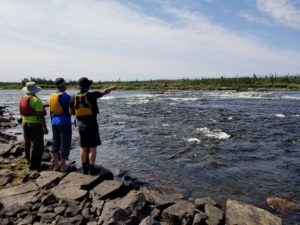 Another famous rapid on the Seal River is Nine Bar Rapids. The Canadian Heritage Rivers System notes had this classified as a Class 6 at one point. That would have been some pretty wild water levels, or they perhaps were a little too focused at the ledges at the bottom of this section of the river. Hap’s book also refers to the Class 6 exaggeration, but still classifies it as a C4. By this time, we had paddled enough rapids and had a real feel for our canoes and the flow and composition of the rapids, so we had a good rhythm and confidence necessary for success. Nine Bar could end up being one of the biggest challenges though. We had pulled over to a rocky outcropping where we could see the rapid downstream and had a quick snack break. We could see from this spot that approaching the rapid on the left shore would be the best and we proceeded downstream. In some areas on the river there were so many strewn boulders that getting to shore was not always easy. We picked our way to the left shore where we saw a break in the rocks and got out, secured the boats and began to hike further downstream to scout. We made our way a couple hundred yards down the river to a few large boulders a couple meters high. From the tops of these we could see that the river provided numerous paths through the large waves, boulders, and holes. River left looked to be the best option and because the rapid was long, 2-3 km, being closer to shore would allow us to possibly get out and scout later on. Regan and I led the crew down and we were all successful, each having a ton of fun side-slipping our way through. After the first section of rapids the river opened up a bit and we moved center left to find deeper water to navigate our way though. It was tons of fun and we were getting caught up in the fun when I remembered the notes mentioned a large shelf at the bottom of the rapid. Scanning ahead I could see a horizon line caused by elevation drops and I began to lead the crew to the river left shore to get out again and scout. We got out of the canoes and hiked the left side to see that the ledge was quite large, and there did not seem to be any lines that would be very successful to paddle though.
Another famous rapid on the Seal River is Nine Bar Rapids. The Canadian Heritage Rivers System notes had this classified as a Class 6 at one point. That would have been some pretty wild water levels, or they perhaps were a little too focused at the ledges at the bottom of this section of the river. Hap’s book also refers to the Class 6 exaggeration, but still classifies it as a C4. By this time, we had paddled enough rapids and had a real feel for our canoes and the flow and composition of the rapids, so we had a good rhythm and confidence necessary for success. Nine Bar could end up being one of the biggest challenges though. We had pulled over to a rocky outcropping where we could see the rapid downstream and had a quick snack break. We could see from this spot that approaching the rapid on the left shore would be the best and we proceeded downstream. In some areas on the river there were so many strewn boulders that getting to shore was not always easy. We picked our way to the left shore where we saw a break in the rocks and got out, secured the boats and began to hike further downstream to scout. We made our way a couple hundred yards down the river to a few large boulders a couple meters high. From the tops of these we could see that the river provided numerous paths through the large waves, boulders, and holes. River left looked to be the best option and because the rapid was long, 2-3 km, being closer to shore would allow us to possibly get out and scout later on. Regan and I led the crew down and we were all successful, each having a ton of fun side-slipping our way through. After the first section of rapids the river opened up a bit and we moved center left to find deeper water to navigate our way though. It was tons of fun and we were getting caught up in the fun when I remembered the notes mentioned a large shelf at the bottom of the rapid. Scanning ahead I could see a horizon line caused by elevation drops and I began to lead the crew to the river left shore to get out again and scout. We got out of the canoes and hiked the left side to see that the ledge was quite large, and there did not seem to be any lines that would be very successful to paddle though.
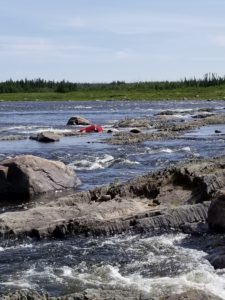 There was the possibility that center right of the rapid would have some safe options but getting across to scout would be too time consuming and difficult. Tight to the left there was a series of little channels that we could easily line the canoes through. Disappointed that we would not run every rapid on the Seal cleanly, but still a win because we did not have to portage! At the bottom of the ledge approx. 60-70 yards offshore there was a sign of someone else’s unsuccessful run down the rapid. There was a red Old Town canoe folded in the rocks and now a part of the rapid, at least until next spring’s flood. The red colour of the canoe was still bright and new, leading us to believe it was likely from a group paddling this year. We had heard from the pilots dropping us off at Tadoule Lake that there was another group on the Seal at least 2 weeks prior to us. We figured this canoe would have to be from that group, and so we wondered about the circumstances that might have led to the canoe getting here. My best guess was that the canoe capsized upstream and found its way to this spot in the ledge, where it folded into the rocks. We hoped everyone was okay and that not too much gear was lost or damaged. Between the damaged canoe, and the grey wolf encounter at this location that I mentioned earlier, Nine Bar rapids was a very memorable spot.
There was the possibility that center right of the rapid would have some safe options but getting across to scout would be too time consuming and difficult. Tight to the left there was a series of little channels that we could easily line the canoes through. Disappointed that we would not run every rapid on the Seal cleanly, but still a win because we did not have to portage! At the bottom of the ledge approx. 60-70 yards offshore there was a sign of someone else’s unsuccessful run down the rapid. There was a red Old Town canoe folded in the rocks and now a part of the rapid, at least until next spring’s flood. The red colour of the canoe was still bright and new, leading us to believe it was likely from a group paddling this year. We had heard from the pilots dropping us off at Tadoule Lake that there was another group on the Seal at least 2 weeks prior to us. We figured this canoe would have to be from that group, and so we wondered about the circumstances that might have led to the canoe getting here. My best guess was that the canoe capsized upstream and found its way to this spot in the ledge, where it folded into the rocks. We hoped everyone was okay and that not too much gear was lost or damaged. Between the damaged canoe, and the grey wolf encounter at this location that I mentioned earlier, Nine Bar rapids was a very memorable spot.
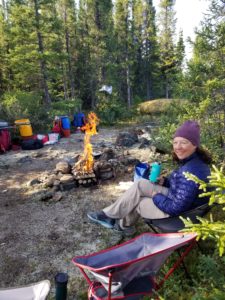 On day 6 of our journey we came to the water survey station which is located just east of the Great Island. We paddled up to the rocky shore and tied up our boats so we could explore the cabin. This cabin is mentioned in both Hap Wilson’s book and other published notes where some people have even spent the night in the cabin. It is stocked with some provisions so if someone suffered any drastic issues upstream from here, they could restock to get them through to the coast. There were bunks to sleep on and a table and chairs set. On the table there were various postcards and notes left by previous paddlers, including a new logbook where paddlers have listed their greetings dating back to 1998. There were also a few humorous references to Hap taking the original logbook from the cabin out of fear of the fires burning and pleading for him to return it. The notes that made the most significance to us were scrawled on the back of a post card from Kevin Schultz, my paddling mentor, in 1995 and again in ‘96. He had written in 1996, “Hi to Bill Jeffery on your next time through, now 3 times for me, Kevin Schultz.” Bill Jeffery is another avid paddler, instructor, and did various guiding for many groups throughout northern Saskatchewan. I had spoken to Bill before paddling the Seal River because he had paddled it, and other rivers in the area, in the 1970’s. Kevin first paddled the river with a group of his friends in the early 90’s and even paddled in Hudson Bay to Churchill, something that is NOT recommended. He also guided different groups down the river in 1995 & ‘96. Kevin was considering going with our team 4 years earlier when our trip was cancelled due to the rail shut down. We ended up paddling the Hawkrock River in SK that summer with him instead. The truth is the trip we got to experience on the Seal River was more of an adventure than it would have been if we had someone with us that had paddled it before, but any time or trip spent with Kevin is always such a reward. While we were at the cabin, we looked in the journal and notes around the table for any clue of what could have happened upstream at Nine Bar ledge leaving that canoe wrapped like it was, but we couldn’t find anything. We would have loved to stay longer and read all the journal entries, but we needed to push on to find camp for the night. I paddled away from the cabin having thanked Kevin in the logbook for all the skills he had passed on to me over the years allowing me to be so comfortable in this remote, rugged environment.
On day 6 of our journey we came to the water survey station which is located just east of the Great Island. We paddled up to the rocky shore and tied up our boats so we could explore the cabin. This cabin is mentioned in both Hap Wilson’s book and other published notes where some people have even spent the night in the cabin. It is stocked with some provisions so if someone suffered any drastic issues upstream from here, they could restock to get them through to the coast. There were bunks to sleep on and a table and chairs set. On the table there were various postcards and notes left by previous paddlers, including a new logbook where paddlers have listed their greetings dating back to 1998. There were also a few humorous references to Hap taking the original logbook from the cabin out of fear of the fires burning and pleading for him to return it. The notes that made the most significance to us were scrawled on the back of a post card from Kevin Schultz, my paddling mentor, in 1995 and again in ‘96. He had written in 1996, “Hi to Bill Jeffery on your next time through, now 3 times for me, Kevin Schultz.” Bill Jeffery is another avid paddler, instructor, and did various guiding for many groups throughout northern Saskatchewan. I had spoken to Bill before paddling the Seal River because he had paddled it, and other rivers in the area, in the 1970’s. Kevin first paddled the river with a group of his friends in the early 90’s and even paddled in Hudson Bay to Churchill, something that is NOT recommended. He also guided different groups down the river in 1995 & ‘96. Kevin was considering going with our team 4 years earlier when our trip was cancelled due to the rail shut down. We ended up paddling the Hawkrock River in SK that summer with him instead. The truth is the trip we got to experience on the Seal River was more of an adventure than it would have been if we had someone with us that had paddled it before, but any time or trip spent with Kevin is always such a reward. While we were at the cabin, we looked in the journal and notes around the table for any clue of what could have happened upstream at Nine Bar ledge leaving that canoe wrapped like it was, but we couldn’t find anything. We would have loved to stay longer and read all the journal entries, but we needed to push on to find camp for the night. I paddled away from the cabin having thanked Kevin in the logbook for all the skills he had passed on to me over the years allowing me to be so comfortable in this remote, rugged environment.
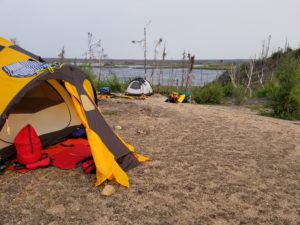 The camping on the Seal River ranges from beach spots that you can make the best of, right up to some 5-star locations that have consistently been used over the years because of their flat tent spots, amazing views, accessibility to hikes, and spacing along the route. The site where we camped on Shethanei Lake, which was noted to be a location that Samuel Hearne camped at, or near, while making his overland trek in 1770, would be one of the nicest camp spots on the trip. The paths between tents spots looked worn enough that perhaps locals from Tadoule spend some time here. Having spent the majority of our canoe tripping time in the Canadian Shield in Northern SK our crew was used to some pretty nice camp spots. If we had more spare time on the trip it would have been nice to log a few of the better camp spots for future paddlers. Overall, we usually had a pretty flat spot for our tents, and enough space to keep our cooking & food barrels far enough away from our tents for animal safety. As all wilderness campers know, home is what you make of it, so even though our initial thoughts of a campsite were sometimes disappointment, looking back at pictures and recalling memories now, they were all pretty good. Some of the sites that stick out above the others would be our spot on the Great Island which offered tons of open space. The sandy beach island ended up working out great for us, but if wind and weather would have rolled in that could have been a very different story. The high esker we needed to lug all our stuff up, ended up providing one of the best evening hikes you could ever ask for, even though the bugs were quite awful that night. Having to leave our firebox out of our gear due to weight restrictions on the substituted planes we ended up flying in, our crew was able to create or rebuild some fantastic fire pits to cook on.
The camping on the Seal River ranges from beach spots that you can make the best of, right up to some 5-star locations that have consistently been used over the years because of their flat tent spots, amazing views, accessibility to hikes, and spacing along the route. The site where we camped on Shethanei Lake, which was noted to be a location that Samuel Hearne camped at, or near, while making his overland trek in 1770, would be one of the nicest camp spots on the trip. The paths between tents spots looked worn enough that perhaps locals from Tadoule spend some time here. Having spent the majority of our canoe tripping time in the Canadian Shield in Northern SK our crew was used to some pretty nice camp spots. If we had more spare time on the trip it would have been nice to log a few of the better camp spots for future paddlers. Overall, we usually had a pretty flat spot for our tents, and enough space to keep our cooking & food barrels far enough away from our tents for animal safety. As all wilderness campers know, home is what you make of it, so even though our initial thoughts of a campsite were sometimes disappointment, looking back at pictures and recalling memories now, they were all pretty good. Some of the sites that stick out above the others would be our spot on the Great Island which offered tons of open space. The sandy beach island ended up working out great for us, but if wind and weather would have rolled in that could have been a very different story. The high esker we needed to lug all our stuff up, ended up providing one of the best evening hikes you could ever ask for, even though the bugs were quite awful that night. Having to leave our firebox out of our gear due to weight restrictions on the substituted planes we ended up flying in, our crew was able to create or rebuild some fantastic fire pits to cook on.
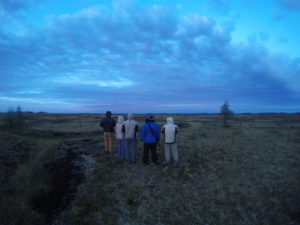 One of the challenging logistics of paddling the Seal River is paddling through the delta into Hudson Bay. You need to know the tide chart so you can plan to paddle during high tide to have enough water to float your canoe. The coast is the most likely place where you will have polar bear encounters, so you have to be on the lookout for them. There is a Class 4 rapid called Deaf Falls that you need to navigate through, not to mention the advanced map reading skills to navigate the dozens of paddling routes in the delta. We had been using Colin’s satellite phone to keep in touch with Wally from Lazy Bear Lodge to plan our pickup in Hudson Bay. Wally has a very large boat called the Samuel Hearne but even his boat is not big enough to manage the rough waters of Hudson Bay when it is windy. We knew there was a storm with large winds blowing on the bay the last couple days as we were getting closer to our pickup day. Our plan was to camp within 10-15km of the bay the night before, so we could paddle and arrive at the same time Wally was arriving with his boat. When we contacted him in the morning, Wally told us to call back again at noon to verify the weather and confirm that he could make the trip. We had a leisurely morning and packed up our canoes, leaving the awesome beach island behind us, hoping this would be our last campsite on the Seal River. We began floating downstream, paddling lightly, trying not to get too far before we knew if we had a ride.
One of the challenging logistics of paddling the Seal River is paddling through the delta into Hudson Bay. You need to know the tide chart so you can plan to paddle during high tide to have enough water to float your canoe. The coast is the most likely place where you will have polar bear encounters, so you have to be on the lookout for them. There is a Class 4 rapid called Deaf Falls that you need to navigate through, not to mention the advanced map reading skills to navigate the dozens of paddling routes in the delta. We had been using Colin’s satellite phone to keep in touch with Wally from Lazy Bear Lodge to plan our pickup in Hudson Bay. Wally has a very large boat called the Samuel Hearne but even his boat is not big enough to manage the rough waters of Hudson Bay when it is windy. We knew there was a storm with large winds blowing on the bay the last couple days as we were getting closer to our pickup day. Our plan was to camp within 10-15km of the bay the night before, so we could paddle and arrive at the same time Wally was arriving with his boat. When we contacted him in the morning, Wally told us to call back again at noon to verify the weather and confirm that he could make the trip. We had a leisurely morning and packed up our canoes, leaving the awesome beach island behind us, hoping this would be our last campsite on the Seal River. We began floating downstream, paddling lightly, trying not to get too far before we knew if we had a ride.
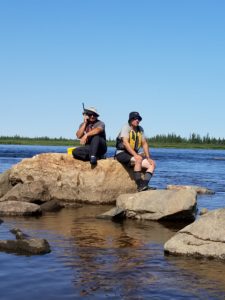 At noon we made the call and found out the bay was too rough, so the pickup would have to be pushed back a day. We were all pretty devastated by the news, and now we needed to find another camp site that would protect us from the bears, but the tundra landscape did not offer up very many options at this point. As we were paddling, we stopped on a small island covered in low brush for a quick snack & bathroom break. We looked at the map again and discussed our limited options. Then we realized we needed to stop sooner than later, or worse yet, start making our way back upstream. I took a second look at this island and realized the brush was super low in spots and it would work to set up our tents for the night. It wasn’t the nicest of camp spots but it did allow us to see 360 degrees around us so we would know if any bears were coming to visit. We now had to kill 24 hours until we would know if we were paddling out the next day. Time is a funny thing, there are so many places on this trip that we would have loved to have more time to spend and now we had to anxiously wait. The next day the call was made, and the pickup was set for 6pm, needless to say we were all excited. I was excited to navigate through the delta and see what our final major rapid, Deaf Falls, would be like. From our island camp spot we had 12 km of distance to cover and a vertical drop of 34 ft until sea level. The report from the call with Wally was that previous tour boat operators had seen 10-12 Bears near the mouth of the Seal River. We knew we needed to be on the look-out and we needed to be careful because a capsize could put us in some real danger. The shot guns were accessible under the spray skirt of both Colin’s and Kevin’s canoes, and I was to be the lead canoe to pick the deepest & safest channels of water. Immediately after leaving the last island camp the landscape changed again, the tundra was still incredibly flat, but the trees disappeared even more and there were rocks everywhere. Year after year of spring flooding and ice flow pushed all the rocks up into piles, and onto the small islands and shorelines. You could see the river drop off in the distance and get incredibly wide as well. We knew Deaf Falls was far left in the delta, so we needed to make more left turns than right as we navigated the dozens of islands. The deeper, safer flow was taking us to the right though, which was a little cause for concern. The rapids were a combination of longer stretches of boulder dodging to short shelf drops. It was a ton of fun to paddle but also a little nerve wracking. We hit a straighter stretch of rapids with a long skinny island on our left which I remembered from the map, and I knew it was time to get over to river left to approach and scout Deaf Falls. We dropped over another shelf and then we could see a narrowing of the river with large waves ahead which had to be Deaf Falls. We stopped in an eddy for a quick snack break and recapped the amazing terrain we had just paddled through. We began to proceed slowly down the river left looking for a way to get to shore to possibly scout this final challenge of a rapid. But with the rocks pushed up and scattered everywhere, it would be a difficult task to get to shore. We eddied out behind some boulders, each canoe in a different eddy so I could come up with a plan to get to shore. While standing up in the stern of my canoe I realized I could see the rapid quite well from our vantage point. There was a nice route down the river left that would work just fine. The center was filled with explosions of water which we needed to stay out of, but it was a pretty impressive rapid, hence why they call it a fall. I shouted back to the crew, “Stay left, there are a couple places you need to go right of a boulder but get back left as quick as you can, and I will see you at the bottom!” I had earned their trust and they knew to follow the leader, so we were good to go. It was such a fun rapid to paddle, we navigated down the left side except where we needed to head right, towards the middle. Regan and I had to put on a strong back ferry in one spot to get the canoe back to the left, and it was powerful enough that we overshot our mark and had to realign before continuing down. I could see Colin and Laurie coming down behind us and we needed to get out of their way. It was impressive to glance over to the center of the flow and see the massive waves exploding. I wouldn’t even want to take a raft through that! We all made it safely to the bottom and let out a cheer. It was the last major hurdle to completing this trip. After looking back up at the rapid we had just come down we turned around to examine the landscape, noticing the river was now only rocky channels as far as the eye could see both left and right of us. The blue of the water seemed to blend with the colour of the sky, and it looked like the river would never end. We had to watch the water carefully to see which channel we would choose to paddle down.
At noon we made the call and found out the bay was too rough, so the pickup would have to be pushed back a day. We were all pretty devastated by the news, and now we needed to find another camp site that would protect us from the bears, but the tundra landscape did not offer up very many options at this point. As we were paddling, we stopped on a small island covered in low brush for a quick snack & bathroom break. We looked at the map again and discussed our limited options. Then we realized we needed to stop sooner than later, or worse yet, start making our way back upstream. I took a second look at this island and realized the brush was super low in spots and it would work to set up our tents for the night. It wasn’t the nicest of camp spots but it did allow us to see 360 degrees around us so we would know if any bears were coming to visit. We now had to kill 24 hours until we would know if we were paddling out the next day. Time is a funny thing, there are so many places on this trip that we would have loved to have more time to spend and now we had to anxiously wait. The next day the call was made, and the pickup was set for 6pm, needless to say we were all excited. I was excited to navigate through the delta and see what our final major rapid, Deaf Falls, would be like. From our island camp spot we had 12 km of distance to cover and a vertical drop of 34 ft until sea level. The report from the call with Wally was that previous tour boat operators had seen 10-12 Bears near the mouth of the Seal River. We knew we needed to be on the look-out and we needed to be careful because a capsize could put us in some real danger. The shot guns were accessible under the spray skirt of both Colin’s and Kevin’s canoes, and I was to be the lead canoe to pick the deepest & safest channels of water. Immediately after leaving the last island camp the landscape changed again, the tundra was still incredibly flat, but the trees disappeared even more and there were rocks everywhere. Year after year of spring flooding and ice flow pushed all the rocks up into piles, and onto the small islands and shorelines. You could see the river drop off in the distance and get incredibly wide as well. We knew Deaf Falls was far left in the delta, so we needed to make more left turns than right as we navigated the dozens of islands. The deeper, safer flow was taking us to the right though, which was a little cause for concern. The rapids were a combination of longer stretches of boulder dodging to short shelf drops. It was a ton of fun to paddle but also a little nerve wracking. We hit a straighter stretch of rapids with a long skinny island on our left which I remembered from the map, and I knew it was time to get over to river left to approach and scout Deaf Falls. We dropped over another shelf and then we could see a narrowing of the river with large waves ahead which had to be Deaf Falls. We stopped in an eddy for a quick snack break and recapped the amazing terrain we had just paddled through. We began to proceed slowly down the river left looking for a way to get to shore to possibly scout this final challenge of a rapid. But with the rocks pushed up and scattered everywhere, it would be a difficult task to get to shore. We eddied out behind some boulders, each canoe in a different eddy so I could come up with a plan to get to shore. While standing up in the stern of my canoe I realized I could see the rapid quite well from our vantage point. There was a nice route down the river left that would work just fine. The center was filled with explosions of water which we needed to stay out of, but it was a pretty impressive rapid, hence why they call it a fall. I shouted back to the crew, “Stay left, there are a couple places you need to go right of a boulder but get back left as quick as you can, and I will see you at the bottom!” I had earned their trust and they knew to follow the leader, so we were good to go. It was such a fun rapid to paddle, we navigated down the left side except where we needed to head right, towards the middle. Regan and I had to put on a strong back ferry in one spot to get the canoe back to the left, and it was powerful enough that we overshot our mark and had to realign before continuing down. I could see Colin and Laurie coming down behind us and we needed to get out of their way. It was impressive to glance over to the center of the flow and see the massive waves exploding. I wouldn’t even want to take a raft through that! We all made it safely to the bottom and let out a cheer. It was the last major hurdle to completing this trip. After looking back up at the rapid we had just come down we turned around to examine the landscape, noticing the river was now only rocky channels as far as the eye could see both left and right of us. The blue of the water seemed to blend with the colour of the sky, and it looked like the river would never end. We had to watch the water carefully to see which channel we would choose to paddle down.
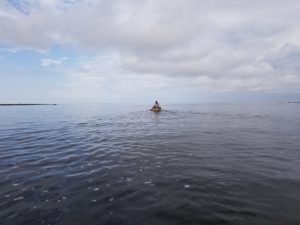 It was so shallow that we barely had enough water to float our boats. Wading and walking at this point was not a great option as it could make us late for our pickup but also leave us more susceptible to bear encounters. It was a maze of rocks and water and we picked our way through it, eventually dropping down to sea level. The cabin appeared on the river left shore which meant we made it to the sea. Across from the cabin on the right was that large male bear I mentioned earlier. He was impressive to see as we paddled safely past into Hudson Bay.
It was so shallow that we barely had enough water to float our boats. Wading and walking at this point was not a great option as it could make us late for our pickup but also leave us more susceptible to bear encounters. It was a maze of rocks and water and we picked our way through it, eventually dropping down to sea level. The cabin appeared on the river left shore which meant we made it to the sea. Across from the cabin on the right was that large male bear I mentioned earlier. He was impressive to see as we paddled safely past into Hudson Bay.
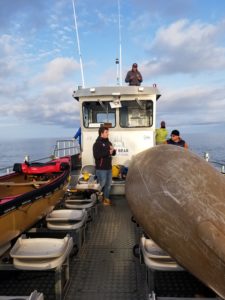 Wally from Lazy Bear Lodge had asked that we paddle out into the bay at least 5km or so to ensure we were in deep enough water for his boat. We had lucked out with the weather as there was not a ripple on the water and we paddled out away from the shore into what seemed like the middle of nowhere. It was a crazy feeling to be sitting out in our canoes, in ocean waters, just waiting and wondering if our pickup would come, unlike all the other previous trips where we would be on shore waiting for a float plane to arrive. The calm and quiet was disturbed by a group of beluga whales that swam over and circled our canoes. An incredible treat for us, and a secret that Colin was keeping having guided in Churchill and on the Knife River in previous years. Off in the distance we could see a boat, but we couldn’t tell if it was Wally or if it was the tour boats from Seal River Adventures which was just north of us. Through the binoculars we could see the boat turn towards us, and Colin could make out the captain’s helm of the Samuel Hearne, the name of Wally’s boat, and we all let out a sigh of relief. I can still feel the
Wally from Lazy Bear Lodge had asked that we paddle out into the bay at least 5km or so to ensure we were in deep enough water for his boat. We had lucked out with the weather as there was not a ripple on the water and we paddled out away from the shore into what seemed like the middle of nowhere. It was a crazy feeling to be sitting out in our canoes, in ocean waters, just waiting and wondering if our pickup would come, unlike all the other previous trips where we would be on shore waiting for a float plane to arrive. The calm and quiet was disturbed by a group of beluga whales that swam over and circled our canoes. An incredible treat for us, and a secret that Colin was keeping having guided in Churchill and on the Knife River in previous years. Off in the distance we could see a boat, but we couldn’t tell if it was Wally or if it was the tour boats from Seal River Adventures which was just north of us. Through the binoculars we could see the boat turn towards us, and Colin could make out the captain’s helm of the Samuel Hearne, the name of Wally’s boat, and we all let out a sigh of relief. I can still feel the
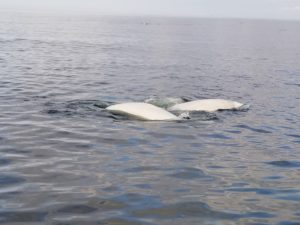 uneasiness I felt waiting for that pickup in those perfect weather conditions just thinking “it’s too good to be true.” I think the entire crew felt that as well. Wally pulled close and we paddled up to the front of his boat where he lowered his custom bridge down for us to start unloading the canoes one at a time. Wally brought a first mate with him named Malcolm, whom we later learned was on the Canadian national team for luge. For the past few days Colin had been telling us about the Lazy Lodge burgers and how delicious they were. Our plan was to order some from the boat to have them ready when we hit town. Just as we loaded the last canoe onto the boat, Wally surprised us with burgers, fries, and cold drinks. It was a fantastic, and delicious surprise. We started heading toward Churchill, but Wally spotted a large pod of beluga whales, so he cut the engines, and we were treated to our own private show of hundreds of
uneasiness I felt waiting for that pickup in those perfect weather conditions just thinking “it’s too good to be true.” I think the entire crew felt that as well. Wally pulled close and we paddled up to the front of his boat where he lowered his custom bridge down for us to start unloading the canoes one at a time. Wally brought a first mate with him named Malcolm, whom we later learned was on the Canadian national team for luge. For the past few days Colin had been telling us about the Lazy Lodge burgers and how delicious they were. Our plan was to order some from the boat to have them ready when we hit town. Just as we loaded the last canoe onto the boat, Wally surprised us with burgers, fries, and cold drinks. It was a fantastic, and delicious surprise. We started heading toward Churchill, but Wally spotted a large pod of beluga whales, so he cut the engines, and we were treated to our own private show of hundreds of
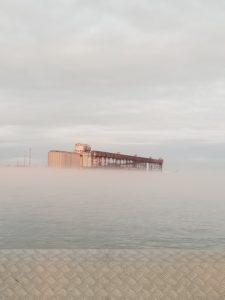 whales swimming around, under, and next to the boat. As we made our way to Churchill, I couldn’t help but think of Kevin Schultz and his friends paddling that river in the early 90’s with very few notes, and paddling Hudson Bay into Churchill. It was getting late and the fog was rolling in, as it typically does in the bay. It was pretty special to see the old Prince of Wales Fort as we rounded the corner to head up the Churchill River into town. Having read tons of books on the history of the fur trade and the battles for control of the Fort over the centuries, to physically be there, will be a top moment in my life, for sure. We pulled up to Wally’s dock where he operates his kayak and boat tours from, and the landmark grain terminal was off to the right. We had just learned that the first shipment of grain since the rail line was reopened was heading out of that terminal next week. It was then time to bed down for the night under a roof, rather than the tents we had become so familiar and comfortable with. With having to spend an extra day on the river, we now only had 1 short day to tour Churchill before taking the train home.
whales swimming around, under, and next to the boat. As we made our way to Churchill, I couldn’t help but think of Kevin Schultz and his friends paddling that river in the early 90’s with very few notes, and paddling Hudson Bay into Churchill. It was getting late and the fog was rolling in, as it typically does in the bay. It was pretty special to see the old Prince of Wales Fort as we rounded the corner to head up the Churchill River into town. Having read tons of books on the history of the fur trade and the battles for control of the Fort over the centuries, to physically be there, will be a top moment in my life, for sure. We pulled up to Wally’s dock where he operates his kayak and boat tours from, and the landmark grain terminal was off to the right. We had just learned that the first shipment of grain since the rail line was reopened was heading out of that terminal next week. It was then time to bed down for the night under a roof, rather than the tents we had become so familiar and comfortable with. With having to spend an extra day on the river, we now only had 1 short day to tour Churchill before taking the train home.
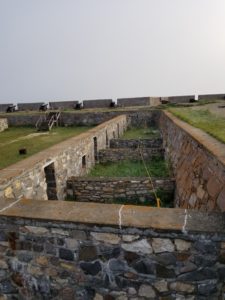 We woke early the next morning because a great opportunity to get a private tour of the Prince of Wales Fort came up. We caught a boat shuttle across the river with Colin’s friend, Gerald, who owns and operates BlueSky Expeditions, which is a dog mushing/bed & breakfast tour operator in Churchill. Colin has spent the last few years mushing for Gerald and his wife, Jenifor. Having Colin and Gerald touring us around the Fort was special as they both know so much of the history and all the fun, secret stories, or legends. Touring the Fort was a top item on Laurie’s list of things to see in Churchill, so she was especially excited for the opportunity. We then headed over to catch the tail end of the breakfast buffet at the Lazy Lizard Lodge. Being noticed as new faces in town, we were asked a few times where we came from, and our answer “via canoe down the Seal River” was met with excitement and a few questions about our journey. The breakfast at Lazy Bear was fabulous for many reasons other than the limitless coffee that I didn’t have to brew. The hotel is beautiful and the dining room spectacular with the wooden beams and structural features. During breakfast we started to realize that Colin was a pretty big deal in Churchill as staff, guides, and town folks were happy and surprised to see him there. We then began our whirlwind tour of the town taking in the museum, the Inushuk, the school, and the Northern Store which had everything from lawnmowers to candy bars and everything in-between.
We woke early the next morning because a great opportunity to get a private tour of the Prince of Wales Fort came up. We caught a boat shuttle across the river with Colin’s friend, Gerald, who owns and operates BlueSky Expeditions, which is a dog mushing/bed & breakfast tour operator in Churchill. Colin has spent the last few years mushing for Gerald and his wife, Jenifor. Having Colin and Gerald touring us around the Fort was special as they both know so much of the history and all the fun, secret stories, or legends. Touring the Fort was a top item on Laurie’s list of things to see in Churchill, so she was especially excited for the opportunity. We then headed over to catch the tail end of the breakfast buffet at the Lazy Lizard Lodge. Being noticed as new faces in town, we were asked a few times where we came from, and our answer “via canoe down the Seal River” was met with excitement and a few questions about our journey. The breakfast at Lazy Bear was fabulous for many reasons other than the limitless coffee that I didn’t have to brew. The hotel is beautiful and the dining room spectacular with the wooden beams and structural features. During breakfast we started to realize that Colin was a pretty big deal in Churchill as staff, guides, and town folks were happy and surprised to see him there. We then began our whirlwind tour of the town taking in the museum, the Inushuk, the school, and the Northern Store which had everything from lawnmowers to candy bars and everything in-between.
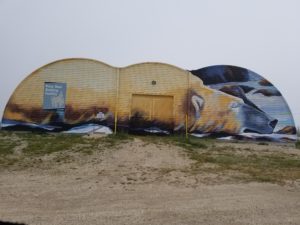 We also toured around to see the various murals that were painted on buildings throughout town during a project called The Seawalls of Churchill. Regan’s friend Kal Barteski was an organizer and one of the artists that collaborated on the project and we got to drive out to the polar bear holding facility (aka polar bear jail) to see her artwork. From there we drove out to Gerald’s dog yard where we were treated to a cart run, and they had clients staying at their B & B who were also there. Jen’s lunch and home-made bannock was delicious, and it was great to learn about how they go way beyond the standard in their industry to care for their dogs.
We also toured around to see the various murals that were painted on buildings throughout town during a project called The Seawalls of Churchill. Regan’s friend Kal Barteski was an organizer and one of the artists that collaborated on the project and we got to drive out to the polar bear holding facility (aka polar bear jail) to see her artwork. From there we drove out to Gerald’s dog yard where we were treated to a cart run, and they had clients staying at their B & B who were also there. Jen’s lunch and home-made bannock was delicious, and it was great to learn about how they go way beyond the standard in their industry to care for their dogs.
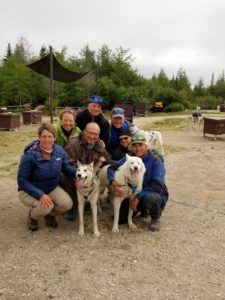 The care & passion that Gerald & Jen have for their dogs and the sledding industry makes them a top choice for anyone looking for cart rides in the summer or fall, or sled rides in the winter. We could easily see why Colin loves working for them so much. It was pretty cool to see Colin up on the cart mushing the dogs down the road. We headed back to town knowing the day was disappearing on us and we still needed to get our canoes and gear to the train station. In full-on redneck style, we loaded 2 canoes across the box of Gerald’s truck, and tied the 3rd canoe to the top of a side-by-side quad and headed with our gear to the train station.
The care & passion that Gerald & Jen have for their dogs and the sledding industry makes them a top choice for anyone looking for cart rides in the summer or fall, or sled rides in the winter. We could easily see why Colin loves working for them so much. It was pretty cool to see Colin up on the cart mushing the dogs down the road. We headed back to town knowing the day was disappearing on us and we still needed to get our canoes and gear to the train station. In full-on redneck style, we loaded 2 canoes across the box of Gerald’s truck, and tied the 3rd canoe to the top of a side-by-side quad and headed with our gear to the train station. 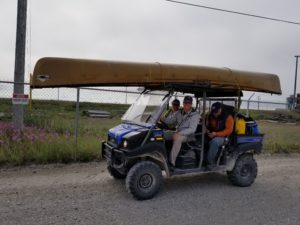 Townsfolk who have probably seen everything, still stopped and took pictures of our spectacle. We loaded our canoes and gear into the train car and headed back to Lazy Bear for supper. While touring around town we asked a few of the guides, and the museum curator if they had heard anything about a crew coming off the Seal River that wrecked their canoe on Nine Bar rapids. Aside from a rumor about a helicopter pick up at the mouth that might have been for this crew, or not, we didn’t hear much. A mystery to still be solved. After a great feast at Lazy Bear it was time to hit up the Northern store for snacks and drinks for the long train ride to Thompson. Between the staff and Wally at Lazy Bear Lodge, Gerald & Jen, _____ at the museum, and ____ at the train station, everyone in Churchill was so kind and generous to us. It was so amazing to be there with Colin, whom they all love and respect. Gerald & Jen made it to the train station to say goodbye and gave us some of her fresh bannock for the trip home. Wally made it to the train station as well, so it was so nice to thank him again for all his hospitality and say goodbye.
Townsfolk who have probably seen everything, still stopped and took pictures of our spectacle. We loaded our canoes and gear into the train car and headed back to Lazy Bear for supper. While touring around town we asked a few of the guides, and the museum curator if they had heard anything about a crew coming off the Seal River that wrecked their canoe on Nine Bar rapids. Aside from a rumor about a helicopter pick up at the mouth that might have been for this crew, or not, we didn’t hear much. A mystery to still be solved. After a great feast at Lazy Bear it was time to hit up the Northern store for snacks and drinks for the long train ride to Thompson. Between the staff and Wally at Lazy Bear Lodge, Gerald & Jen, _____ at the museum, and ____ at the train station, everyone in Churchill was so kind and generous to us. It was so amazing to be there with Colin, whom they all love and respect. Gerald & Jen made it to the train station to say goodbye and gave us some of her fresh bannock for the trip home. Wally made it to the train station as well, so it was so nice to thank him again for all his hospitality and say goodbye.
The train trip from Churchill to Thompson was the final leg of the trip. We had already been warned by Colin of how slow the train travelled, and the VIA staff was mentioning that the train was travelling slower than normal, so we settled in for a long trip through the night. Lucky for us the train was not very full, so we were able to stretch out and have an area all to ourselves. We enjoyed the first part of the trip in our seats taking in the tundra scenery but then made our way to the observation car for better views of the setting sun, and happy hour! Our trip was memorable for so many reasons but to add to the memory was the fact that we were going to be travelling through Gillam, MB which was now famous for the great manhunt of 2019. As it turns out we travelled through Gillam on the same day the 2 fugitives were discovered to be dead in the bush. Not knowing at the time, Kevin stood guard during our Gillam stop on the train, keeping us all safe as we slept through the night. The morning came and we all enjoyed a breakfast in the meal car as we passed next to the Nelson River. We rolled into Thompson late in the afternoon and caught a ride to get our vehicle to load up for the drive back to Saskatchewan.
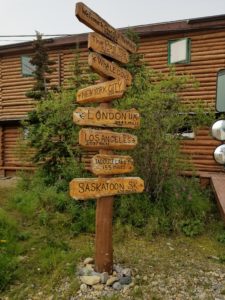 Paddling the Seal River will forever be a favourite trip of mine and I often wonder if I will get the opportunity to paddle it again. Sharing that experience with a group of friends that not only paddled, camped, and travelled so well together, but worked through the challenges of the windy paddling days, the search for camp spots, and the many rapids. Five months after the trip I finally got the chance to talk to Kevin Schultz about our journey. He was surprised and impressed with how many polar bears we saw, and he was interested in how we paddled the rapids. Always my mentor and teacher, he brought to my attention that all my years of teaching paddling, guiding canoe trips, and honing my camping skills had trained me to accomplish an expedition like this. I think about that a lot, and realize we were able to enjoy the rapids more, make better daily decisions, and get along better as a group because of our experience. To quote Kevin, “The thrill is in the skill.”
Paddling the Seal River will forever be a favourite trip of mine and I often wonder if I will get the opportunity to paddle it again. Sharing that experience with a group of friends that not only paddled, camped, and travelled so well together, but worked through the challenges of the windy paddling days, the search for camp spots, and the many rapids. Five months after the trip I finally got the chance to talk to Kevin Schultz about our journey. He was surprised and impressed with how many polar bears we saw, and he was interested in how we paddled the rapids. Always my mentor and teacher, he brought to my attention that all my years of teaching paddling, guiding canoe trips, and honing my camping skills had trained me to accomplish an expedition like this. I think about that a lot, and realize we were able to enjoy the rapids more, make better daily decisions, and get along better as a group because of our experience. To quote Kevin, “The thrill is in the skill.”

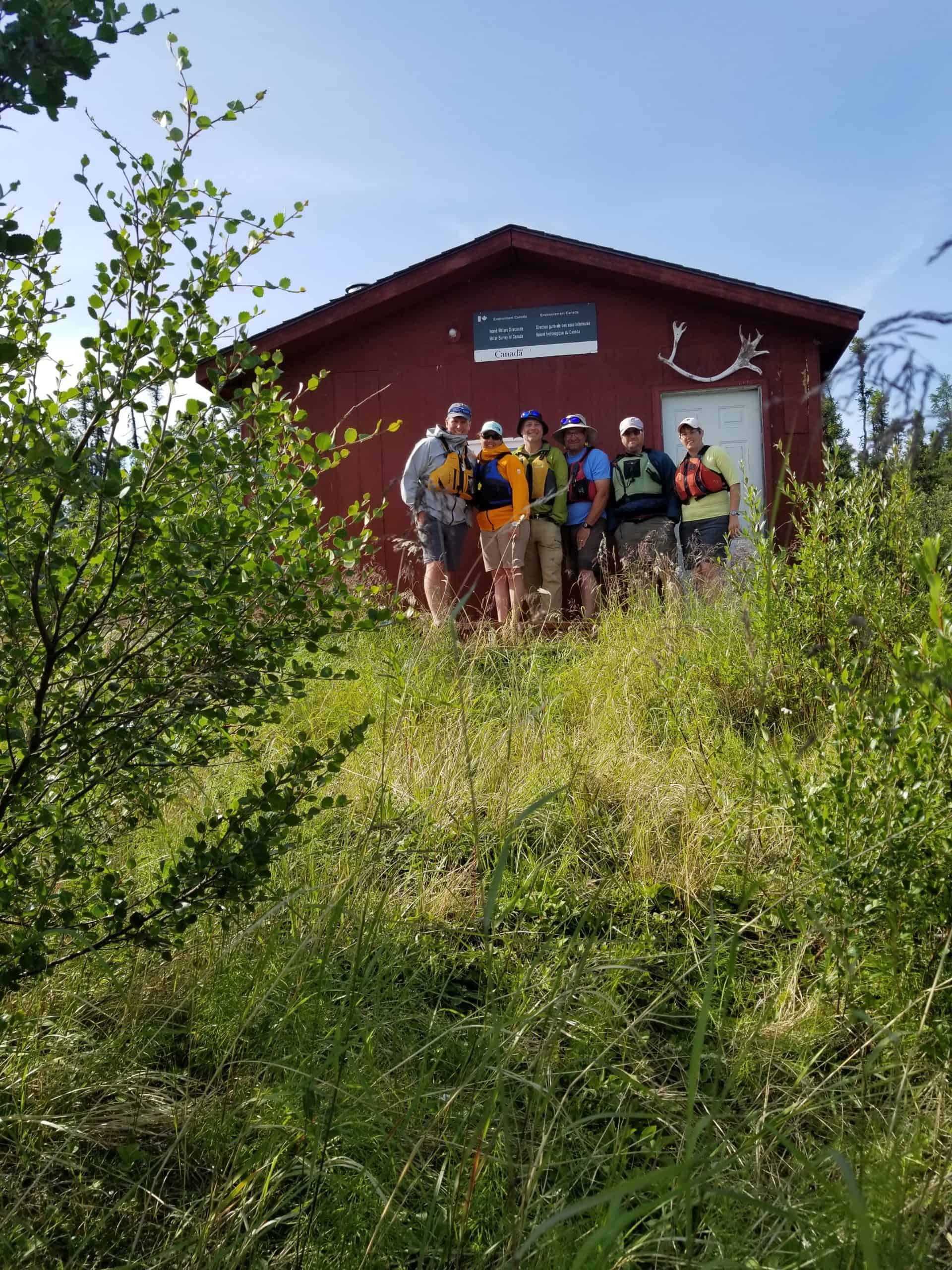
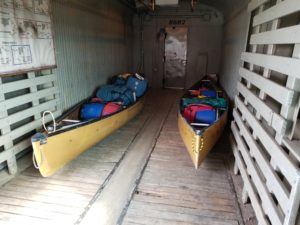
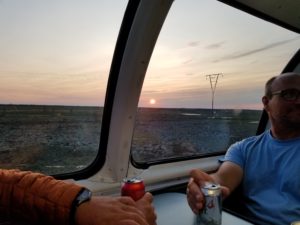
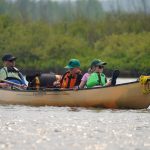
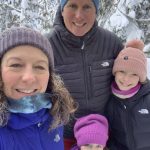
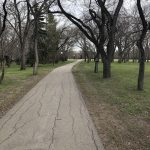
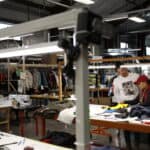



Comments